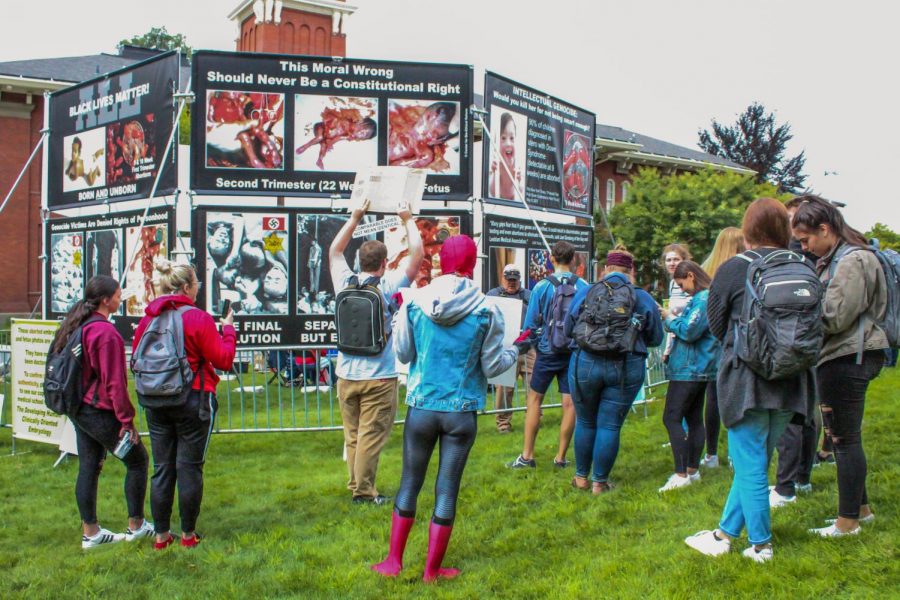OPINION: Demonstrations, discussions should be productive
Recent abortion protest relied on inflammatory imagery, didn’t create constructive conversation
The recent abortion protest used graphic and offensive imagery to compare abortion to the Holocaust, lynchings and other historical genocides. This didn’t further any discussion; it only upset and offended, creating a hostile environment.
October 11, 2019
With the recent and controversial anti-abortion demonstration at WSU, we need to emphasize genuine discussion of not just abortion, but all difficult topics. College students need to be able to think critically about complex ideas and different perspectives, and the only way to do that is to engage with those we disagree with.
The Genocide Awareness Project (GAP) is a nationwide anti-abortion demonstration group that believes abortion is murder, and by extension, genocide.
“The GAP project basically goes to campuses and brings awareness of abortion, what it is, [and] what it looks like,” said Sabrina Johnson, a junior at WSU who volunteered for GAP during their appearance.
GAP demonstrations come to campus after being invited by a student organization. While some might disagree, the point of GAP’s demonstration — as described by Johnson and their materials — is not more contentious than what one would expect from any anti-abortion organization.
One of the main controversies surrounding the demonstration wasn’t its anti-abortion message, but the imagery used to convey it: graphic images of allegedly aborted fetuses positioned directly next to images from the Holocaust, lynchings and historic atrocities. The demonstration had a strong message that some took as extremely hostile.
Even though the protesters may have genuinely believed that abortion is genocide and had the demonstration with the intention of sparking conversation and debate, but many onlookers did not leave with the notion of intellectual discourse.
That’s the real crux of the issue, not that GAP was spreading an anti-abortion message, but that it did so in an inflammatory way. While Johnson said she believes that she was able to have good conversations with those that would talk, the environment did not foster peaceful discussions.
The demonstration didn’t create a campus-wide murmur about just the imagery, but of the nature of the speech demonstrated and whether it had a place on campus.
While many found the way that the demonstrators went about their message offensive, that doesn’t mean that the group shouldn’t be allowed to demonstrate.
“Simply saying offensive things that people may be offended by, that’s not fighting words, that’s not incitement,” WSU government professor Cornell Clayton said. “The speech has got to be the verbal equivalent of punching somebody in the nose. It’s got to be aimed at specific individuals, not groups of people.”
While the comparisons given may have felt correct to the anti-abortion demonstrators, it doesn’t change the fact that the brutal imagery wasn’t conducive to a free discussion of the abortion debate.
“The real question, it seems to me, is not ‘whether they have the right to express those views,’ the question ought to be ‘what is an effective communication strategy?’” Clayton said. “If the goal is to convince other people to your point of view, is the best way to do that to offend them? Or is a more effective communication strategy one where you engage in a reasoned form of discussion and discourse?”
In our polarized society, we tend to separate from those with whom we disagree. Sometimes it’s for the best, you shouldn’t surround yourself with people who hate you for your ideas or actively persecute your beliefs.
By using more aggressive tactics to capture attention, you lose respect and the potential for a good conversation. In the end, even those protesting may feel these tactics are unproductive and are more trouble than they’re worth.
“I’m kind of disappointed that [the posters comparing abortion to historical genocide] is one of the only things that people took away. Of course, I wish it wasn’t,” Johnson said. “It was at a point then where people weren’t even necessarily talking about abortion.”























Jason • Oct 11, 2019 at 2:59 pm
Your article acknowledges the inflammatory and offensive nature of the imagery, and the false equivalence to swastikas and lynching – and yet, this newspaper continues to publish (for the second time now) these very same images. While this article is well written, and the points made are valid, re-hashing this time and time again is not necessary.
Jeff • Oct 11, 2019 at 11:34 am
Perhaps you don’t understand the gathering wasn’t meant to promote debate. The graphic images of people dying and torn up in car wrecks from drunk drivers was never meant to promote debate, it’s meant to scare you and make you think about not doing that.
When you consider the many options available short of killing the baby I think some guilt is in order when an abortion occurs. With IUD’s, condoms, birth control pills and other options it seems to me quite irresponsible to get an abortion at all. When a woman does the father’s feelings on the matter are rarely considered, the chant is my body my choice. Yet if a woman chooses to have the baby and the father doesn’t contribute he becomes a dead beat dad, if she gets public assistance the State will come after him for money and support.
My main point and feeling is that it would be so much better if people would be responsible and just prevent the pregnancy. Our society has foregone personal responsibility and not for it’s betterment.